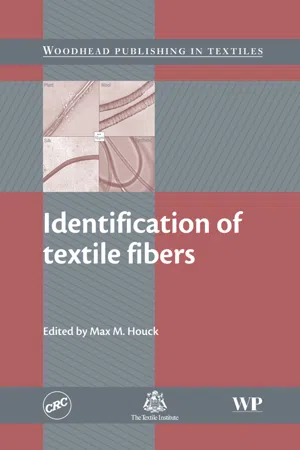![]()
![]()
Manufacturers use set methods to ensure a quality product fit for purpose. This implies a market-based taxonomy with a company-product orientation, a supply chain of raw and processed materials, and explicit rules on categories. For example, the American Association of Textile Chemists and Colorists (AATCC) lists the following specified methods:
• colorfastness to commercial laundering and to domestic washing
• flammability of clothing textiles
• smoothness of seams in fabrics after repeated home laundering
• electrostatic propensity of carpets
• wrinkle recovery of fabrics: appearance method
• dimensional changes in textiles other than wool.
The titles to these methods indicate what is important to define in their products. AATCC lists microscopy as a method to identify fibers but notes that it should be used with caution since manufactured fibers are frequently produced in a number of modifications which alter their appearance.1 The Association also lists ‘reaction to flame’ (Table III) as a test method with the following diagnostics: melts near flame, shrinks from flame, burns in flame, etc.
By contrast, ASTM International lists the following in their methods:
• flame resistant materials used in camping tentage
• pile retention of corduroy fabrics
• elastic properties of textile fibers
• performance specifications for underwear fabrics, woven, men’s and boys’
• commercial moisture regains for textile fibers.
While the view is similar to that of AATCC, ASTM International lists infrared spectroscopy as the preferred method for fiber identification: ‘additional physical properties of the fibers such as density, melting point, regain, refractive indices, and birefringence… are useful for confirming the identification’ (Volume 7.01, D276). Both organizations treat the samples as bulk for purposes of the possible identifying tests; after all, if you make them, sample size should not be a problem.
By comparison, the forensic sciences treat microscopy as the primary method for fiber identification:
Microscopic examination provides the quickest, most accurate, and least destructive means of determining the microscopic characteristics and polymer type of textile fibers. Additionally, a point-by-point, side-by-side microscopic comparison provides the most discriminating method of determining if two or more fibers are consistent with originating from the same source.2
Forensic fiber examiners use microscopy first and then other methods, such as infrared spectroscopy, as confirmatory techniques. Why not start with infrared spectroscopy, as do the manufacturers? A company that spins fibers knows what products it makes; therefore, the universe of possible answers is sufficiently limited. For a forensic scientist, however, fibers found at a crime scene could conceivably be from nearly any source and you can’t make assumptions. A rayon fiber and a cotton fiber will both show up as ‘cellulose’ on an infrared spectrum; a microscope easily distinguishes between them. Two nylon 6,6 fibers may be chemically identical but have different diameters, cross-sections, or birefringences.
The orientation of the analysis is different (comparison), although the goal is partially the same (identification). Forensic fiber analysis routinely has minimal samples with which to work and this structures what tests can be used. Forensic fiber analysis is also interested in traits of which the manufacturers may not be aware. For example, delustrants, typically titanium dioxide, are added to deluster or dull otherwise bright fibers. The manufacturers add the delustrants during the fiber spinning process at a certain rate to achieve the desired end goals with little regard for the distribution of the granules within the fiber. For ...
